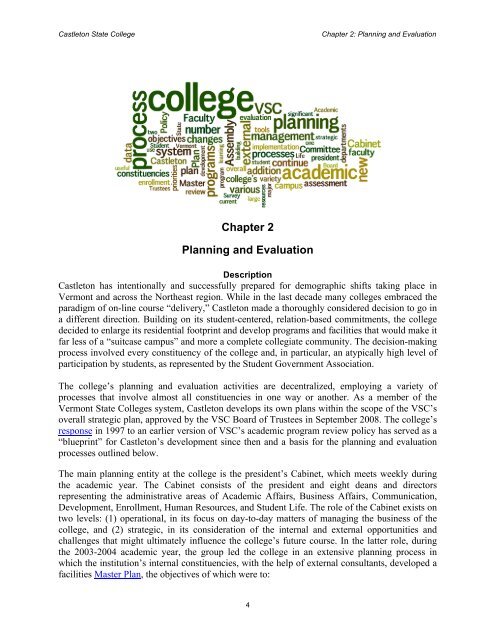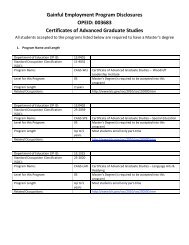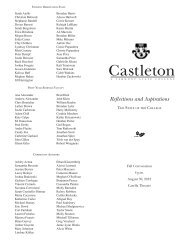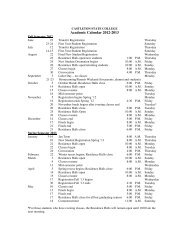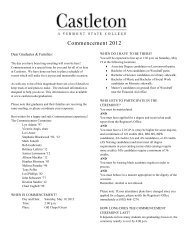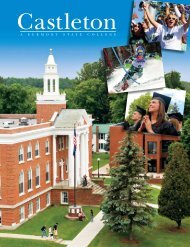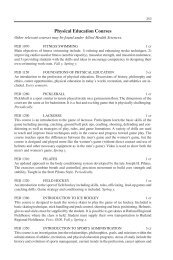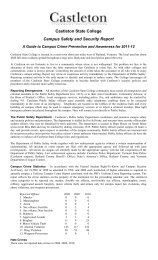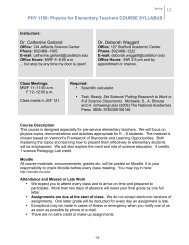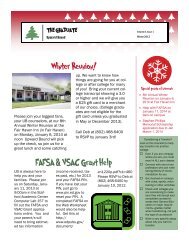Castle<strong>to</strong>n <strong>State</strong> CollegeChapter 2: Planning and EvaluationChapter 2Planning and EvaluationDescriptionCastle<strong>to</strong>n has intentionally and successfully prepared for demographic shifts taking place inVermont and across the Northeast region. While in the last decade many colleges embraced theparadigm of on-line course “delivery,” Castle<strong>to</strong>n made a thoroughly considered decision <strong>to</strong> go ina different direction. Building on its student-centered, relation-based commitments, the collegedecided <strong>to</strong> enlarge its residential footprint and develop programs and facilities that would make itfar less of a “suitcase campus” and more a complete collegiate community. The decision-makingprocess involved every constituency of the college and, in particular, an atypically high level ofparticipation by students, as represented by the Student Government Association.The college’s planning and evaluation activities are decentralized, employing a variety ofprocesses that involve almost all constituencies in one way or another. As a member of theVermont <strong>State</strong> Colleges system, Castle<strong>to</strong>n develops its own plans within the scope of the VSC’soverall strategic plan, approved by the VSC Board of Trustees in <strong>September</strong> 2008. The college’sresponse in 1997 <strong>to</strong> an earlier version of VSC’s academic program review policy has served as a“blueprint” for Castle<strong>to</strong>n’s development since then and a basis for the planning and evaluationprocesses outlined below.The main planning entity at the college is the president’s Cabinet, which meets weekly duringthe academic year. The Cabinet consists of the president and eight deans and direc<strong>to</strong>rsrepresenting the administrative areas of Academic Affairs, Business Affairs, Communication,Development, Enrollment, Human Resources, and Student Life. The role of the Cabinet exists ontwo levels: (1) operational, in its focus on day-<strong>to</strong>-day matters of managing the business of thecollege, and (2) strategic, in its consideration of the internal and external opportunities andchallenges that might ultimately influence the college’s future course. In the latter role, duringthe 2003-2004 academic year, the group led the college in an extensive planning process inwhich the institution’s internal constituencies, with the help of external consultants, developed afacilities Master Plan, the objectives of which were <strong>to</strong>:4
Castle<strong>to</strong>n <strong>State</strong> CollegeChapter 2: Planning and Evaluation1. Identify high priority health, safety, and preservation-of-facility projects <strong>to</strong> ensure theongoing operation of the college.2. Conduct a space assessment <strong>to</strong> determine future space requirements.3. Identify the highest priority building renovation and/or expansion needs <strong>to</strong> ensure thatcampus program requirements are met.The Cabinet continues <strong>to</strong> lead an ongoing planning process, and each year the president outlinesa list of priorities at Convocation that is distributed widely among internal and externalconstituencies. In fall 2009, President Wolk announced two continuing priorities (the CHANGEinitiative—Creating, Honoring, Advocating, and Nurturing Gender Equity—and the GreenCampus Initiative) and one new one (a diversity initiative). In August 2010, the presidentunveiled Project 2012, an initiative intended <strong>to</strong> address the college’s need for more housing, asidentified in the most recent revision of the Master Plan.The Cabinet regularly reviews enrollment projections and sets recruiting targets in light ofenrollment capacity as determined in the college’s 2004 Master Plan. In addition, a subset of theCabinet (the CFO and the president) regularly reviews budget forecasts, including multi-yearforecasts, using a model developed by a former budget direc<strong>to</strong>r.Individual college units employ planning processes that take a wide variety of forms and rangefrom highly formal <strong>to</strong> ad hoc. On one end of the range are Financial Aid, whose planning isheavily prescribed by state and federal actions, as well as the Faculty Assembly, whose role isdescribed contractually; on the other end are ad hoc groups such as the Leavenworth BuildingCommittee, which arose internally in Castle<strong>to</strong>n’s busiest academic building <strong>to</strong> improveconditions there.The Faculty Assembly, which includes all full-time members of the faculty and rankedlibrarians, is charged with planning and executing policies related <strong>to</strong> the college’s educationalprogram in accordance with the Agreement between Vermont <strong>State</strong> Colleges and Vermont <strong>State</strong>Colleges Faculty Federation. It serves as the deliberative body on matters related <strong>to</strong> educationalpolicy and, through its various standing committees (described in Chapters 3 and 5 of this self<strong>study</strong>),conducts the ongoing governance work of the faculty.The Faculty Assembly’s Executive Council initiates and oversees the work of the Assembly. TheExecutive Council consists of three officers (president, vice-president, and secretary) and threeat-large members elected according <strong>to</strong> Assembly by-laws, a parliamentarian appointed by theAssembly president, and the chairperson of the local chapter of the Faculty Federation, whoserves as an ex officio member. At times, the Executive Council and the Cabinet have met prior<strong>to</strong> the start of the academic year <strong>to</strong> review their respective plans, priorities, and areas of concernin order <strong>to</strong> facilitate communication and collaboration between the faculty and the administrationon issues of common concern. In 2010, the Assembly president had individual meetings with anumber of Cabinet members.The Program Assessment Committee, a standing committee of the Faculty Assembly, assists inthe development of responses <strong>to</strong> the VSC’s Policy 101 (Program Review and Continuous5


